Examining Self-Checkout Systems & Customer Satisfaction at Tesco
VerifiedAdded on 2020/06/05
|41
|11664
|29
Dissertation
AI Summary
This dissertation investigates the influence of self-checkout systems (SCS) on customer satisfaction within Tesco supermarkets. The study employs a mixed-methods approach, including an online survey of 120 shoppers and semi-structured interviews with Tesco managers, to assess the effectiveness of SCS and understand customer and management perspectives. The research explores the evolution of SCS in response to technological advancements and competitive pressures, examining its impact on service quality, customer experience, and cost reduction. Findings reveal that younger demographics favor SCS due to its speed and convenience, while management views SCS as a long-term investment. The dissertation analyzes both quantitative and qualitative data, providing a comprehensive assessment of the advantages and disadvantages of SCS adoption within Tesco, and offers recommendations for enhancing customer satisfaction through the implementation of this technology.
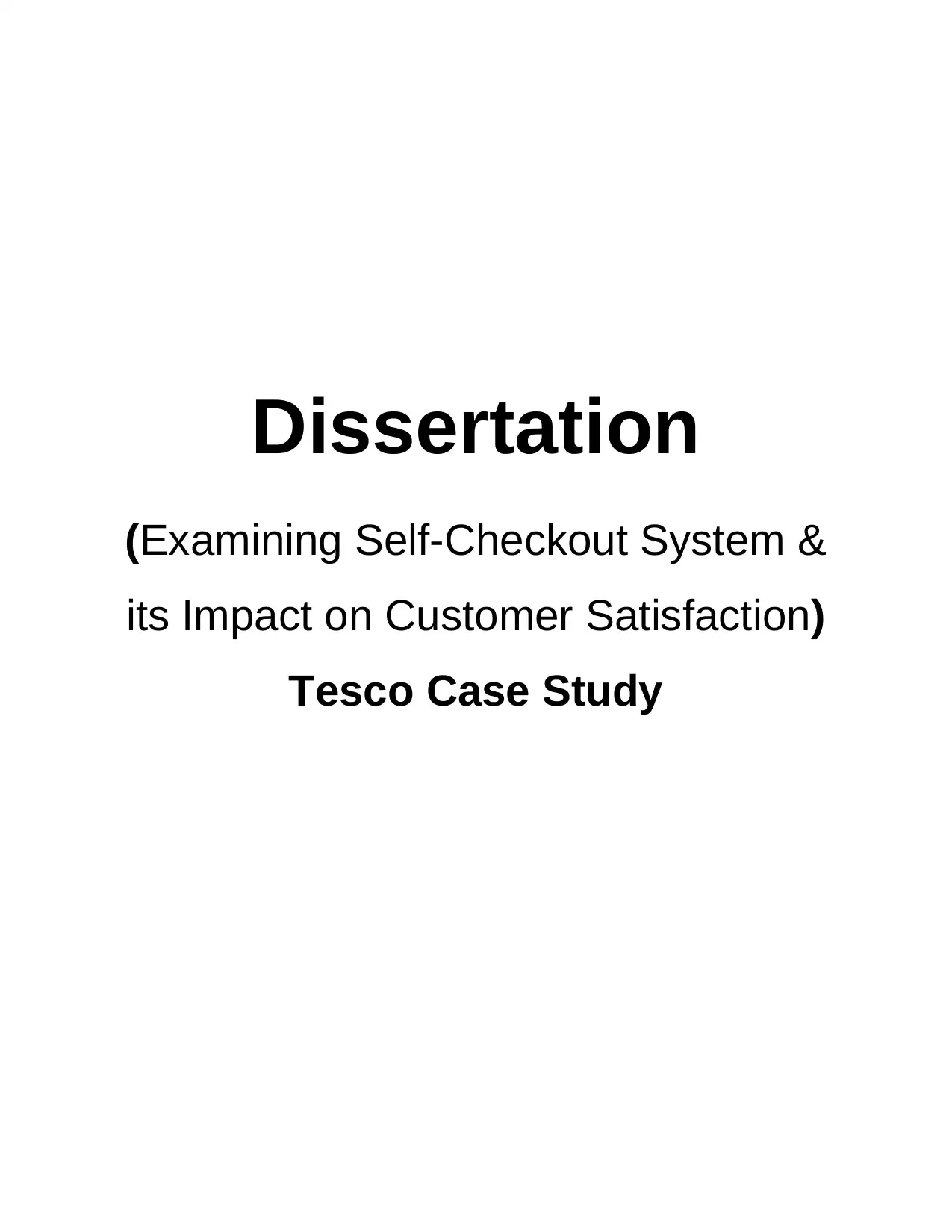
Dissertation
(Examining Self-Checkout System &
its Impact on Customer Satisfaction)
Tesco Case Study
(Examining Self-Checkout System &
its Impact on Customer Satisfaction)
Tesco Case Study
Paraphrase This Document
Need a fresh take? Get an instant paraphrase of this document with our AI Paraphraser
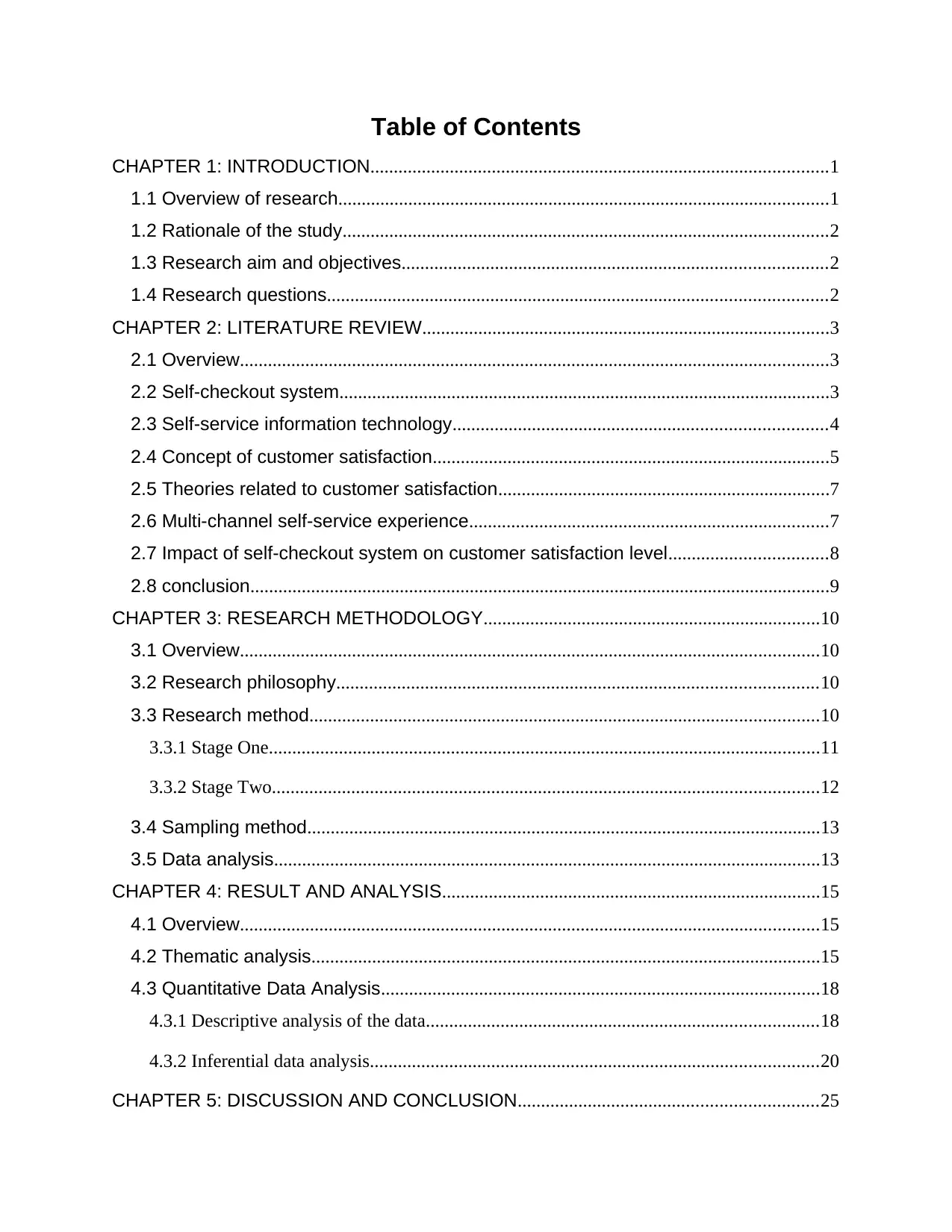
Table of Contents
CHAPTER 1: INTRODUCTION..................................................................................................1
1.1 Overview of research.........................................................................................................1
1.2 Rationale of the study........................................................................................................2
1.3 Research aim and objectives...........................................................................................2
1.4 Research questions...........................................................................................................2
CHAPTER 2: LITERATURE REVIEW.......................................................................................3
2.1 Overview..............................................................................................................................3
2.2 Self-checkout system.........................................................................................................3
2.3 Self-service information technology................................................................................4
2.4 Concept of customer satisfaction.....................................................................................5
2.5 Theories related to customer satisfaction.......................................................................7
2.6 Multi-channel self-service experience.............................................................................7
2.7 Impact of self-checkout system on customer satisfaction level..................................8
2.8 conclusion............................................................................................................................9
CHAPTER 3: RESEARCH METHODOLOGY........................................................................10
3.1 Overview............................................................................................................................10
3.2 Research philosophy.......................................................................................................10
3.3 Research method.............................................................................................................10
3.3.1 Stage One......................................................................................................................11
3.3.2 Stage Two.....................................................................................................................12
3.4 Sampling method..............................................................................................................13
3.5 Data analysis.....................................................................................................................13
CHAPTER 4: RESULT AND ANALYSIS.................................................................................15
4.1 Overview............................................................................................................................15
4.2 Thematic analysis.............................................................................................................15
4.3 Quantitative Data Analysis..............................................................................................18
4.3.1 Descriptive analysis of the data....................................................................................18
4.3.2 Inferential data analysis................................................................................................20
CHAPTER 5: DISCUSSION AND CONCLUSION................................................................25
CHAPTER 1: INTRODUCTION..................................................................................................1
1.1 Overview of research.........................................................................................................1
1.2 Rationale of the study........................................................................................................2
1.3 Research aim and objectives...........................................................................................2
1.4 Research questions...........................................................................................................2
CHAPTER 2: LITERATURE REVIEW.......................................................................................3
2.1 Overview..............................................................................................................................3
2.2 Self-checkout system.........................................................................................................3
2.3 Self-service information technology................................................................................4
2.4 Concept of customer satisfaction.....................................................................................5
2.5 Theories related to customer satisfaction.......................................................................7
2.6 Multi-channel self-service experience.............................................................................7
2.7 Impact of self-checkout system on customer satisfaction level..................................8
2.8 conclusion............................................................................................................................9
CHAPTER 3: RESEARCH METHODOLOGY........................................................................10
3.1 Overview............................................................................................................................10
3.2 Research philosophy.......................................................................................................10
3.3 Research method.............................................................................................................10
3.3.1 Stage One......................................................................................................................11
3.3.2 Stage Two.....................................................................................................................12
3.4 Sampling method..............................................................................................................13
3.5 Data analysis.....................................................................................................................13
CHAPTER 4: RESULT AND ANALYSIS.................................................................................15
4.1 Overview............................................................................................................................15
4.2 Thematic analysis.............................................................................................................15
4.3 Quantitative Data Analysis..............................................................................................18
4.3.1 Descriptive analysis of the data....................................................................................18
4.3.2 Inferential data analysis................................................................................................20
CHAPTER 5: DISCUSSION AND CONCLUSION................................................................25
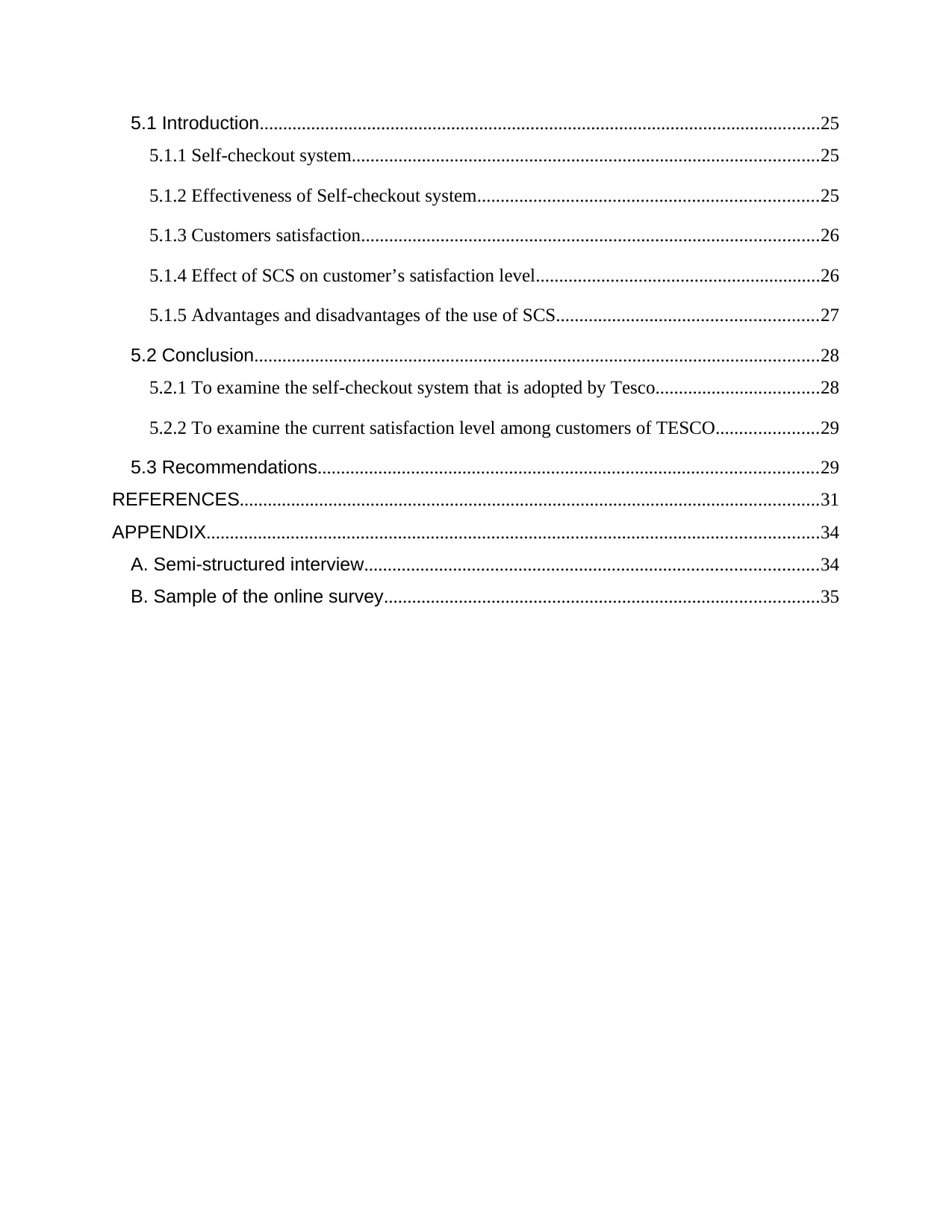
5.1 Introduction........................................................................................................................25
5.1.1 Self-checkout system....................................................................................................25
5.1.2 Effectiveness of Self-checkout system.........................................................................25
5.1.3 Customers satisfaction..................................................................................................26
5.1.4 Effect of SCS on customer’s satisfaction level.............................................................26
5.1.5 Advantages and disadvantages of the use of SCS........................................................27
5.2 Conclusion.........................................................................................................................28
5.2.1 To examine the self-checkout system that is adopted by Tesco...................................28
5.2.2 To examine the current satisfaction level among customers of TESCO......................29
5.3 Recommendations...........................................................................................................29
REFERENCES............................................................................................................................31
APPENDIX...................................................................................................................................34
A. Semi-structured interview.................................................................................................34
B. Sample of the online survey.............................................................................................35
5.1.1 Self-checkout system....................................................................................................25
5.1.2 Effectiveness of Self-checkout system.........................................................................25
5.1.3 Customers satisfaction..................................................................................................26
5.1.4 Effect of SCS on customer’s satisfaction level.............................................................26
5.1.5 Advantages and disadvantages of the use of SCS........................................................27
5.2 Conclusion.........................................................................................................................28
5.2.1 To examine the self-checkout system that is adopted by Tesco...................................28
5.2.2 To examine the current satisfaction level among customers of TESCO......................29
5.3 Recommendations...........................................................................................................29
REFERENCES............................................................................................................................31
APPENDIX...................................................................................................................................34
A. Semi-structured interview.................................................................................................34
B. Sample of the online survey.............................................................................................35
⊘ This is a preview!⊘
Do you want full access?
Subscribe today to unlock all pages.

Trusted by 1+ million students worldwide

List of Figures
Figure 1:Age group of the respondents...................................................................................18
Figure 2: Ease to use the SCS.................................................................................................19
Figure 1:Age group of the respondents...................................................................................18
Figure 2: Ease to use the SCS.................................................................................................19
Paraphrase This Document
Need a fresh take? Get an instant paraphrase of this document with our AI Paraphraser
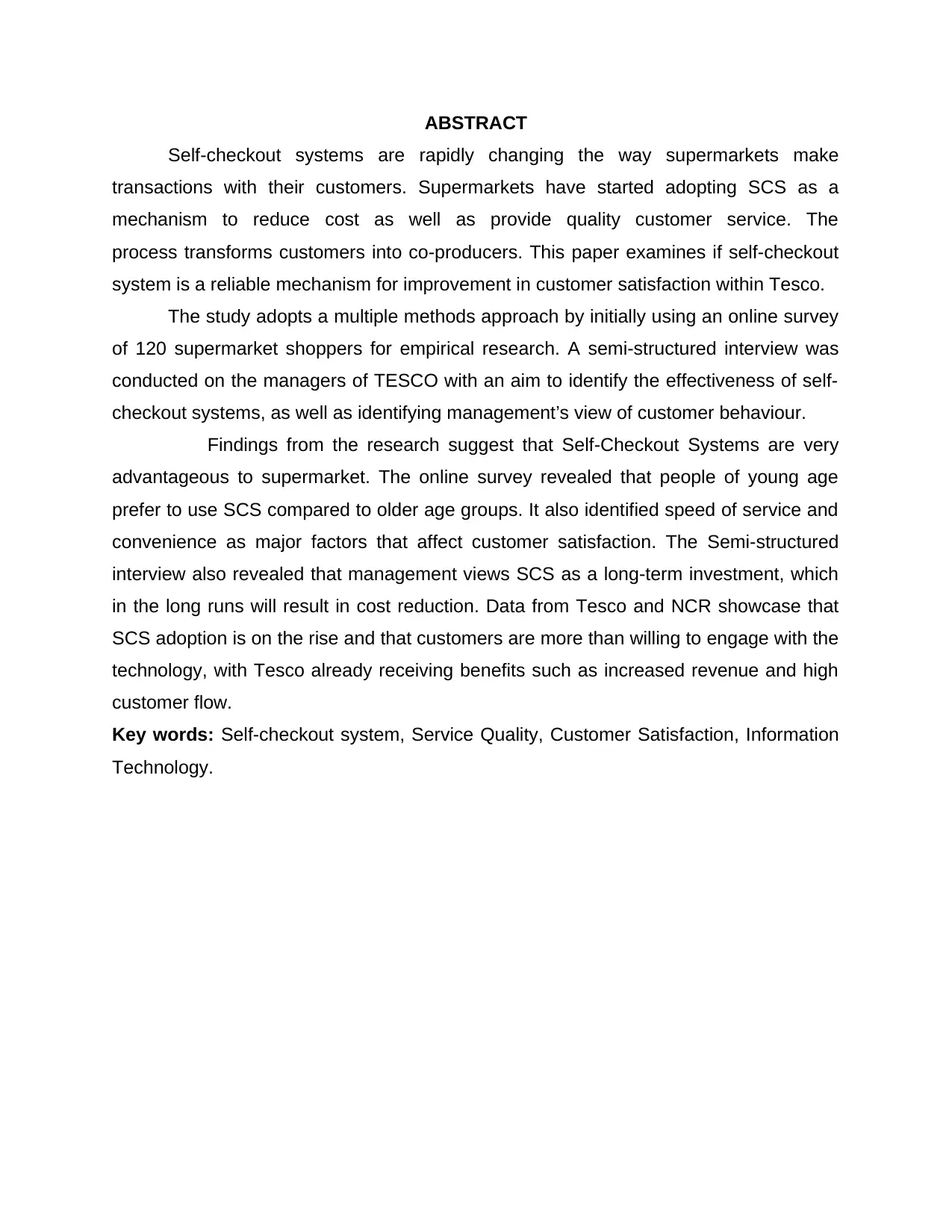
ABSTRACT
Self-checkout systems are rapidly changing the way supermarkets make
transactions with their customers. Supermarkets have started adopting SCS as a
mechanism to reduce cost as well as provide quality customer service. The
process transforms customers into co-producers. This paper examines if self-checkout
system is a reliable mechanism for improvement in customer satisfaction within Tesco.
The study adopts a multiple methods approach by initially using an online survey
of 120 supermarket shoppers for empirical research. A semi-structured interview was
conducted on the managers of TESCO with an aim to identify the effectiveness of self-
checkout systems, as well as identifying management’s view of customer behaviour.
Findings from the research suggest that Self-Checkout Systems are very
advantageous to supermarket. The online survey revealed that people of young age
prefer to use SCS compared to older age groups. It also identified speed of service and
convenience as major factors that affect customer satisfaction. The Semi-structured
interview also revealed that management views SCS as a long-term investment, which
in the long runs will result in cost reduction. Data from Tesco and NCR showcase that
SCS adoption is on the rise and that customers are more than willing to engage with the
technology, with Tesco already receiving benefits such as increased revenue and high
customer flow.
Key words: Self-checkout system, Service Quality, Customer Satisfaction, Information
Technology.
Self-checkout systems are rapidly changing the way supermarkets make
transactions with their customers. Supermarkets have started adopting SCS as a
mechanism to reduce cost as well as provide quality customer service. The
process transforms customers into co-producers. This paper examines if self-checkout
system is a reliable mechanism for improvement in customer satisfaction within Tesco.
The study adopts a multiple methods approach by initially using an online survey
of 120 supermarket shoppers for empirical research. A semi-structured interview was
conducted on the managers of TESCO with an aim to identify the effectiveness of self-
checkout systems, as well as identifying management’s view of customer behaviour.
Findings from the research suggest that Self-Checkout Systems are very
advantageous to supermarket. The online survey revealed that people of young age
prefer to use SCS compared to older age groups. It also identified speed of service and
convenience as major factors that affect customer satisfaction. The Semi-structured
interview also revealed that management views SCS as a long-term investment, which
in the long runs will result in cost reduction. Data from Tesco and NCR showcase that
SCS adoption is on the rise and that customers are more than willing to engage with the
technology, with Tesco already receiving benefits such as increased revenue and high
customer flow.
Key words: Self-checkout system, Service Quality, Customer Satisfaction, Information
Technology.
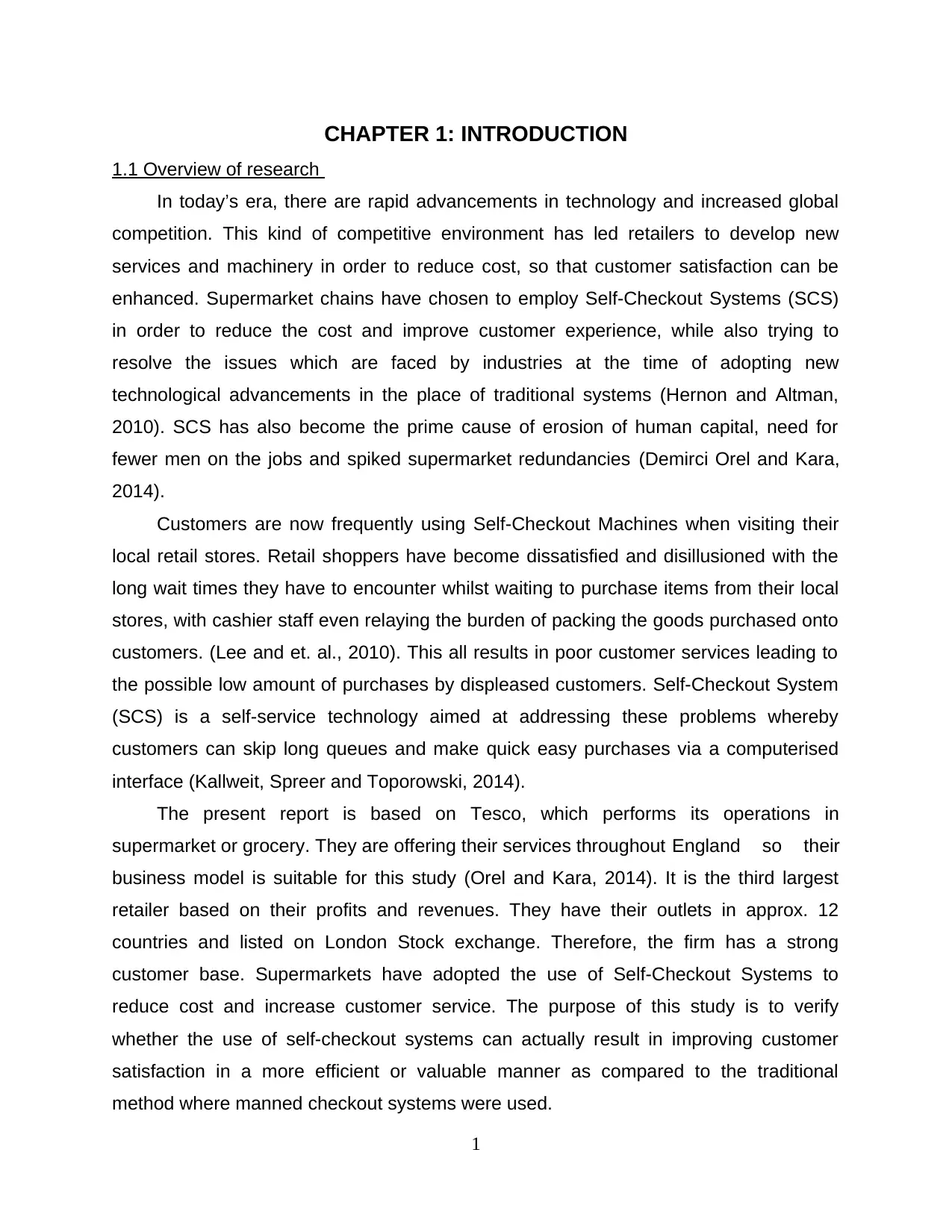
CHAPTER 1: INTRODUCTION
1.1 Overview of research
In today’s era, there are rapid advancements in technology and increased global
competition. This kind of competitive environment has led retailers to develop new
services and machinery in order to reduce cost, so that customer satisfaction can be
enhanced. Supermarket chains have chosen to employ Self-Checkout Systems (SCS)
in order to reduce the cost and improve customer experience, while also trying to
resolve the issues which are faced by industries at the time of adopting new
technological advancements in the place of traditional systems (Hernon and Altman,
2010). SCS has also become the prime cause of erosion of human capital, need for
fewer men on the jobs and spiked supermarket redundancies (Demirci Orel and Kara,
2014).
Customers are now frequently using Self-Checkout Machines when visiting their
local retail stores. Retail shoppers have become dissatisfied and disillusioned with the
long wait times they have to encounter whilst waiting to purchase items from their local
stores, with cashier staff even relaying the burden of packing the goods purchased onto
customers. (Lee and et. al., 2010). This all results in poor customer services leading to
the possible low amount of purchases by displeased customers. Self-Checkout System
(SCS) is a self-service technology aimed at addressing these problems whereby
customers can skip long queues and make quick easy purchases via a computerised
interface (Kallweit, Spreer and Toporowski, 2014).
The present report is based on Tesco, which performs its operations in
supermarket or grocery. They are offering their services throughout England so their
business model is suitable for this study (Orel and Kara, 2014). It is the third largest
retailer based on their profits and revenues. They have their outlets in approx. 12
countries and listed on London Stock exchange. Therefore, the firm has a strong
customer base. Supermarkets have adopted the use of Self-Checkout Systems to
reduce cost and increase customer service. The purpose of this study is to verify
whether the use of self-checkout systems can actually result in improving customer
satisfaction in a more efficient or valuable manner as compared to the traditional
method where manned checkout systems were used.
1
1.1 Overview of research
In today’s era, there are rapid advancements in technology and increased global
competition. This kind of competitive environment has led retailers to develop new
services and machinery in order to reduce cost, so that customer satisfaction can be
enhanced. Supermarket chains have chosen to employ Self-Checkout Systems (SCS)
in order to reduce the cost and improve customer experience, while also trying to
resolve the issues which are faced by industries at the time of adopting new
technological advancements in the place of traditional systems (Hernon and Altman,
2010). SCS has also become the prime cause of erosion of human capital, need for
fewer men on the jobs and spiked supermarket redundancies (Demirci Orel and Kara,
2014).
Customers are now frequently using Self-Checkout Machines when visiting their
local retail stores. Retail shoppers have become dissatisfied and disillusioned with the
long wait times they have to encounter whilst waiting to purchase items from their local
stores, with cashier staff even relaying the burden of packing the goods purchased onto
customers. (Lee and et. al., 2010). This all results in poor customer services leading to
the possible low amount of purchases by displeased customers. Self-Checkout System
(SCS) is a self-service technology aimed at addressing these problems whereby
customers can skip long queues and make quick easy purchases via a computerised
interface (Kallweit, Spreer and Toporowski, 2014).
The present report is based on Tesco, which performs its operations in
supermarket or grocery. They are offering their services throughout England so their
business model is suitable for this study (Orel and Kara, 2014). It is the third largest
retailer based on their profits and revenues. They have their outlets in approx. 12
countries and listed on London Stock exchange. Therefore, the firm has a strong
customer base. Supermarkets have adopted the use of Self-Checkout Systems to
reduce cost and increase customer service. The purpose of this study is to verify
whether the use of self-checkout systems can actually result in improving customer
satisfaction in a more efficient or valuable manner as compared to the traditional
method where manned checkout systems were used.
1
⊘ This is a preview!⊘
Do you want full access?
Subscribe today to unlock all pages.

Trusted by 1+ million students worldwide
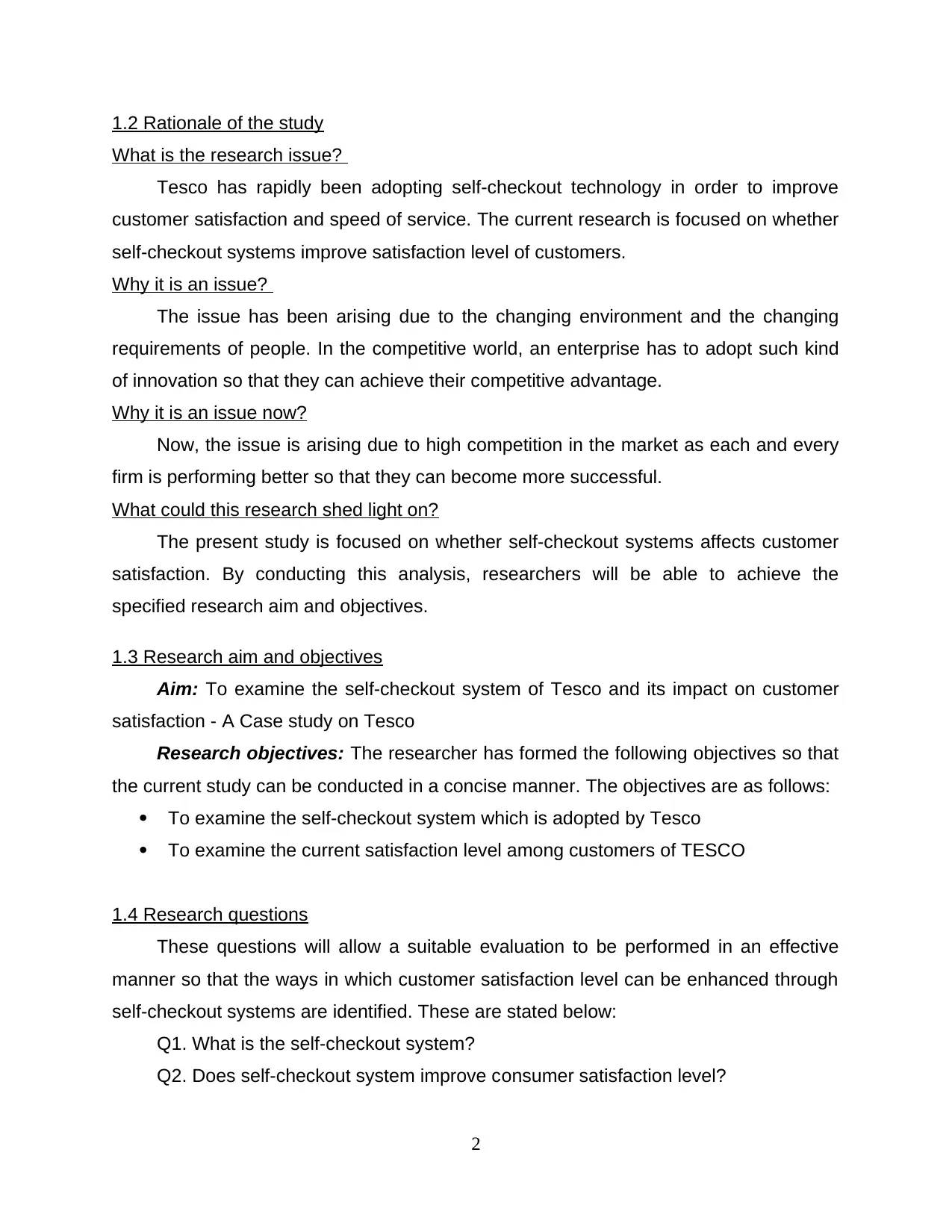
1.2 Rationale of the study
What is the research issue?
Tesco has rapidly been adopting self-checkout technology in order to improve
customer satisfaction and speed of service. The current research is focused on whether
self-checkout systems improve satisfaction level of customers.
Why it is an issue?
The issue has been arising due to the changing environment and the changing
requirements of people. In the competitive world, an enterprise has to adopt such kind
of innovation so that they can achieve their competitive advantage.
Why it is an issue now?
Now, the issue is arising due to high competition in the market as each and every
firm is performing better so that they can become more successful.
What could this research shed light on?
The present study is focused on whether self-checkout systems affects customer
satisfaction. By conducting this analysis, researchers will be able to achieve the
specified research aim and objectives.
1.3 Research aim and objectives
Aim: To examine the self-checkout system of Tesco and its impact on customer
satisfaction - A Case study on Tesco
Research objectives: The researcher has formed the following objectives so that
the current study can be conducted in a concise manner. The objectives are as follows:
To examine the self-checkout system which is adopted by Tesco
To examine the current satisfaction level among customers of TESCO
1.4 Research questions
These questions will allow a suitable evaluation to be performed in an effective
manner so that the ways in which customer satisfaction level can be enhanced through
self-checkout systems are identified. These are stated below:
Q1. What is the self-checkout system?
Q2. Does self-checkout system improve consumer satisfaction level?
2
What is the research issue?
Tesco has rapidly been adopting self-checkout technology in order to improve
customer satisfaction and speed of service. The current research is focused on whether
self-checkout systems improve satisfaction level of customers.
Why it is an issue?
The issue has been arising due to the changing environment and the changing
requirements of people. In the competitive world, an enterprise has to adopt such kind
of innovation so that they can achieve their competitive advantage.
Why it is an issue now?
Now, the issue is arising due to high competition in the market as each and every
firm is performing better so that they can become more successful.
What could this research shed light on?
The present study is focused on whether self-checkout systems affects customer
satisfaction. By conducting this analysis, researchers will be able to achieve the
specified research aim and objectives.
1.3 Research aim and objectives
Aim: To examine the self-checkout system of Tesco and its impact on customer
satisfaction - A Case study on Tesco
Research objectives: The researcher has formed the following objectives so that
the current study can be conducted in a concise manner. The objectives are as follows:
To examine the self-checkout system which is adopted by Tesco
To examine the current satisfaction level among customers of TESCO
1.4 Research questions
These questions will allow a suitable evaluation to be performed in an effective
manner so that the ways in which customer satisfaction level can be enhanced through
self-checkout systems are identified. These are stated below:
Q1. What is the self-checkout system?
Q2. Does self-checkout system improve consumer satisfaction level?
2
Paraphrase This Document
Need a fresh take? Get an instant paraphrase of this document with our AI Paraphraser
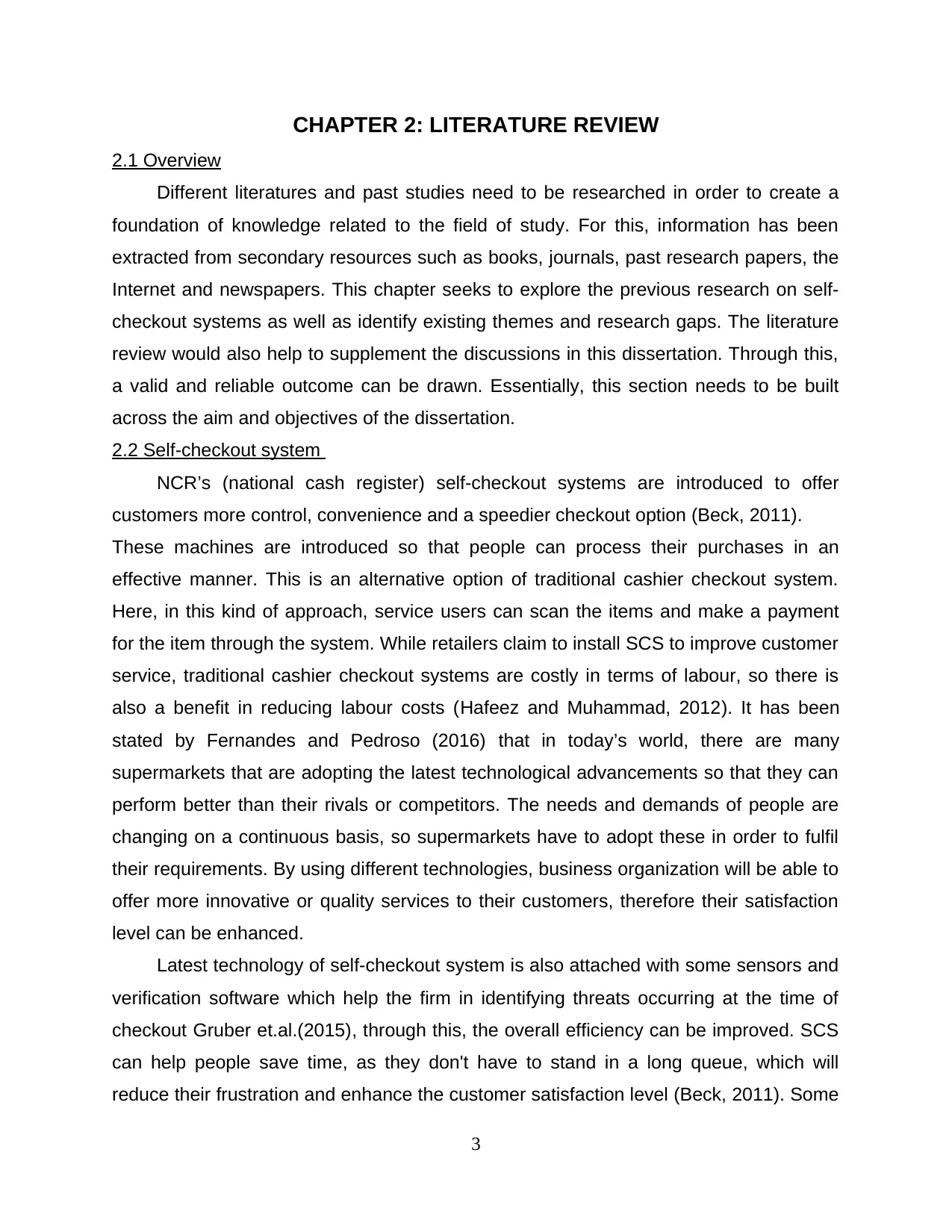
CHAPTER 2: LITERATURE REVIEW
2.1 Overview
Different literatures and past studies need to be researched in order to create a
foundation of knowledge related to the field of study. For this, information has been
extracted from secondary resources such as books, journals, past research papers, the
Internet and newspapers. This chapter seeks to explore the previous research on self-
checkout systems as well as identify existing themes and research gaps. The literature
review would also help to supplement the discussions in this dissertation. Through this,
a valid and reliable outcome can be drawn. Essentially, this section needs to be built
across the aim and objectives of the dissertation.
2.2 Self-checkout system
NCR’s (national cash register) self-checkout systems are introduced to offer
customers more control, convenience and a speedier checkout option (Beck, 2011).
These machines are introduced so that people can process their purchases in an
effective manner. This is an alternative option of traditional cashier checkout system.
Here, in this kind of approach, service users can scan the items and make a payment
for the item through the system. While retailers claim to install SCS to improve customer
service, traditional cashier checkout systems are costly in terms of labour, so there is
also a benefit in reducing labour costs (Hafeez and Muhammad, 2012). It has been
stated by Fernandes and Pedroso (2016) that in today’s world, there are many
supermarkets that are adopting the latest technological advancements so that they can
perform better than their rivals or competitors. The needs and demands of people are
changing on a continuous basis, so supermarkets have to adopt these in order to fulfil
their requirements. By using different technologies, business organization will be able to
offer more innovative or quality services to their customers, therefore their satisfaction
level can be enhanced.
Latest technology of self-checkout system is also attached with some sensors and
verification software which help the firm in identifying threats occurring at the time of
checkout Gruber et.al.(2015), through this, the overall efficiency can be improved. SCS
can help people save time, as they don't have to stand in a long queue, which will
reduce their frustration and enhance the customer satisfaction level (Beck, 2011). Some
3
2.1 Overview
Different literatures and past studies need to be researched in order to create a
foundation of knowledge related to the field of study. For this, information has been
extracted from secondary resources such as books, journals, past research papers, the
Internet and newspapers. This chapter seeks to explore the previous research on self-
checkout systems as well as identify existing themes and research gaps. The literature
review would also help to supplement the discussions in this dissertation. Through this,
a valid and reliable outcome can be drawn. Essentially, this section needs to be built
across the aim and objectives of the dissertation.
2.2 Self-checkout system
NCR’s (national cash register) self-checkout systems are introduced to offer
customers more control, convenience and a speedier checkout option (Beck, 2011).
These machines are introduced so that people can process their purchases in an
effective manner. This is an alternative option of traditional cashier checkout system.
Here, in this kind of approach, service users can scan the items and make a payment
for the item through the system. While retailers claim to install SCS to improve customer
service, traditional cashier checkout systems are costly in terms of labour, so there is
also a benefit in reducing labour costs (Hafeez and Muhammad, 2012). It has been
stated by Fernandes and Pedroso (2016) that in today’s world, there are many
supermarkets that are adopting the latest technological advancements so that they can
perform better than their rivals or competitors. The needs and demands of people are
changing on a continuous basis, so supermarkets have to adopt these in order to fulfil
their requirements. By using different technologies, business organization will be able to
offer more innovative or quality services to their customers, therefore their satisfaction
level can be enhanced.
Latest technology of self-checkout system is also attached with some sensors and
verification software which help the firm in identifying threats occurring at the time of
checkout Gruber et.al.(2015), through this, the overall efficiency can be improved. SCS
can help people save time, as they don't have to stand in a long queue, which will
reduce their frustration and enhance the customer satisfaction level (Beck, 2011). Some
3
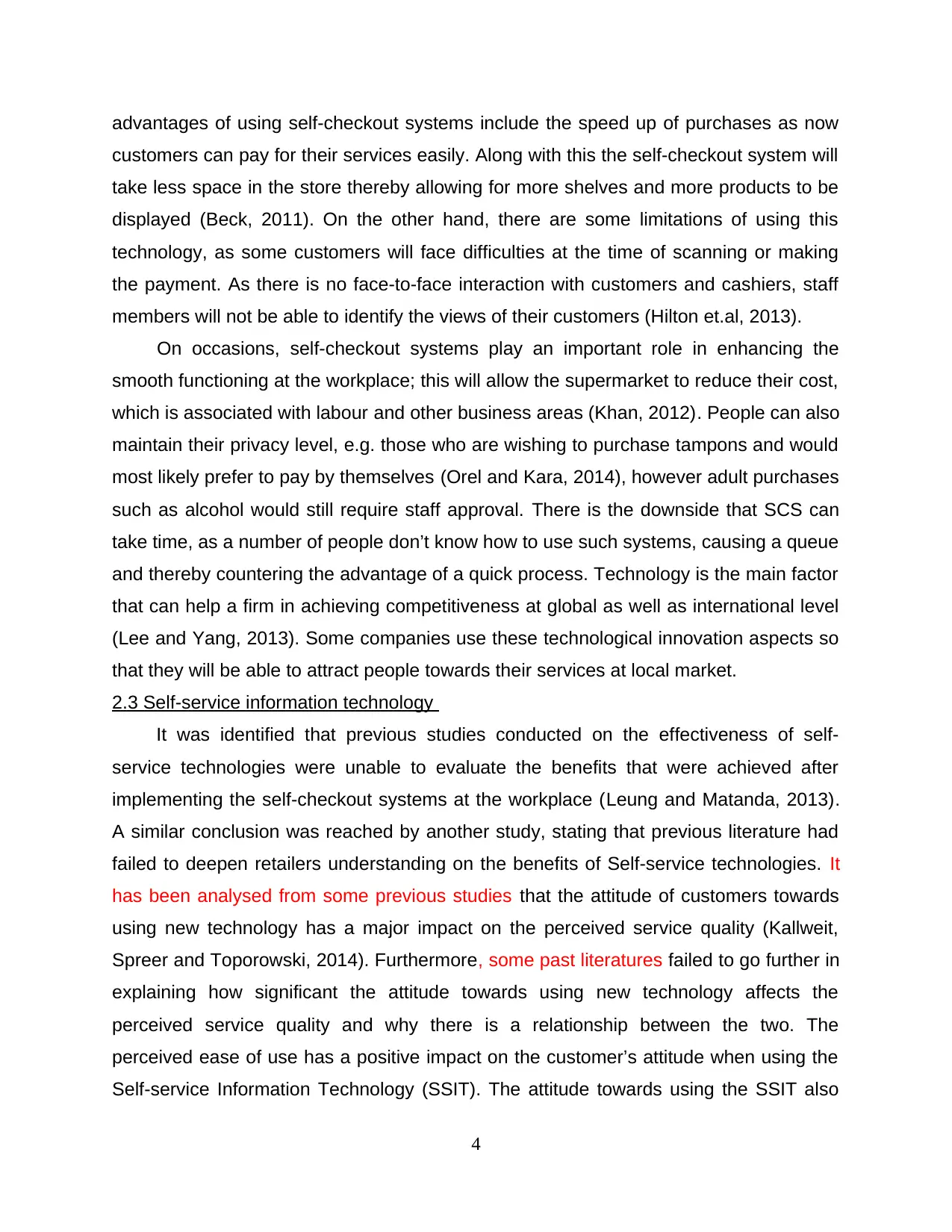
advantages of using self-checkout systems include the speed up of purchases as now
customers can pay for their services easily. Along with this the self-checkout system will
take less space in the store thereby allowing for more shelves and more products to be
displayed (Beck, 2011). On the other hand, there are some limitations of using this
technology, as some customers will face difficulties at the time of scanning or making
the payment. As there is no face-to-face interaction with customers and cashiers, staff
members will not be able to identify the views of their customers (Hilton et.al, 2013).
On occasions, self-checkout systems play an important role in enhancing the
smooth functioning at the workplace; this will allow the supermarket to reduce their cost,
which is associated with labour and other business areas (Khan, 2012). People can also
maintain their privacy level, e.g. those who are wishing to purchase tampons and would
most likely prefer to pay by themselves (Orel and Kara, 2014), however adult purchases
such as alcohol would still require staff approval. There is the downside that SCS can
take time, as a number of people don’t know how to use such systems, causing a queue
and thereby countering the advantage of a quick process. Technology is the main factor
that can help a firm in achieving competitiveness at global as well as international level
(Lee and Yang, 2013). Some companies use these technological innovation aspects so
that they will be able to attract people towards their services at local market.
2.3 Self-service information technology
It was identified that previous studies conducted on the effectiveness of self-
service technologies were unable to evaluate the benefits that were achieved after
implementing the self-checkout systems at the workplace (Leung and Matanda, 2013).
A similar conclusion was reached by another study, stating that previous literature had
failed to deepen retailers understanding on the benefits of Self-service technologies. It
has been analysed from some previous studies that the attitude of customers towards
using new technology has a major impact on the perceived service quality (Kallweit,
Spreer and Toporowski, 2014). Furthermore, some past literatures failed to go further in
explaining how significant the attitude towards using new technology affects the
perceived service quality and why there is a relationship between the two. The
perceived ease of use has a positive impact on the customer’s attitude when using the
Self-service Information Technology (SSIT). The attitude towards using the SSIT also
4
customers can pay for their services easily. Along with this the self-checkout system will
take less space in the store thereby allowing for more shelves and more products to be
displayed (Beck, 2011). On the other hand, there are some limitations of using this
technology, as some customers will face difficulties at the time of scanning or making
the payment. As there is no face-to-face interaction with customers and cashiers, staff
members will not be able to identify the views of their customers (Hilton et.al, 2013).
On occasions, self-checkout systems play an important role in enhancing the
smooth functioning at the workplace; this will allow the supermarket to reduce their cost,
which is associated with labour and other business areas (Khan, 2012). People can also
maintain their privacy level, e.g. those who are wishing to purchase tampons and would
most likely prefer to pay by themselves (Orel and Kara, 2014), however adult purchases
such as alcohol would still require staff approval. There is the downside that SCS can
take time, as a number of people don’t know how to use such systems, causing a queue
and thereby countering the advantage of a quick process. Technology is the main factor
that can help a firm in achieving competitiveness at global as well as international level
(Lee and Yang, 2013). Some companies use these technological innovation aspects so
that they will be able to attract people towards their services at local market.
2.3 Self-service information technology
It was identified that previous studies conducted on the effectiveness of self-
service technologies were unable to evaluate the benefits that were achieved after
implementing the self-checkout systems at the workplace (Leung and Matanda, 2013).
A similar conclusion was reached by another study, stating that previous literature had
failed to deepen retailers understanding on the benefits of Self-service technologies. It
has been analysed from some previous studies that the attitude of customers towards
using new technology has a major impact on the perceived service quality (Kallweit,
Spreer and Toporowski, 2014). Furthermore, some past literatures failed to go further in
explaining how significant the attitude towards using new technology affects the
perceived service quality and why there is a relationship between the two. The
perceived ease of use has a positive impact on the customer’s attitude when using the
Self-service Information Technology (SSIT). The attitude towards using the SSIT also
4
⊘ This is a preview!⊘
Do you want full access?
Subscribe today to unlock all pages.

Trusted by 1+ million students worldwide
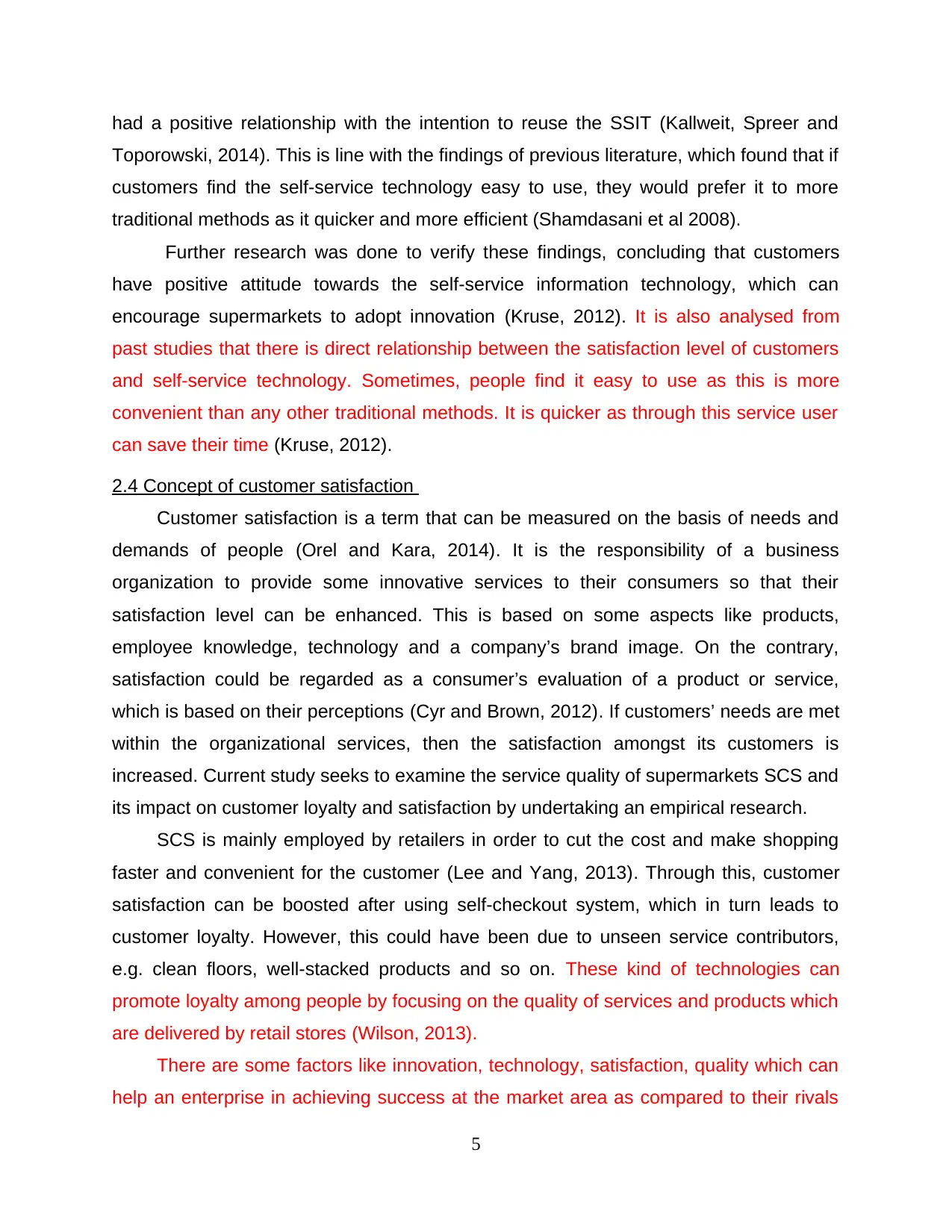
had a positive relationship with the intention to reuse the SSIT (Kallweit, Spreer and
Toporowski, 2014). This is line with the findings of previous literature, which found that if
customers find the self-service technology easy to use, they would prefer it to more
traditional methods as it quicker and more efficient (Shamdasani et al 2008).
Further research was done to verify these findings, concluding that customers
have positive attitude towards the self-service information technology, which can
encourage supermarkets to adopt innovation (Kruse, 2012). It is also analysed from
past studies that there is direct relationship between the satisfaction level of customers
and self-service technology. Sometimes, people find it easy to use as this is more
convenient than any other traditional methods. It is quicker as through this service user
can save their time (Kruse, 2012).
2.4 Concept of customer satisfaction
Customer satisfaction is a term that can be measured on the basis of needs and
demands of people (Orel and Kara, 2014). It is the responsibility of a business
organization to provide some innovative services to their consumers so that their
satisfaction level can be enhanced. This is based on some aspects like products,
employee knowledge, technology and a company’s brand image. On the contrary,
satisfaction could be regarded as a consumer’s evaluation of a product or service,
which is based on their perceptions (Cyr and Brown, 2012). If customers’ needs are met
within the organizational services, then the satisfaction amongst its customers is
increased. Current study seeks to examine the service quality of supermarkets SCS and
its impact on customer loyalty and satisfaction by undertaking an empirical research.
SCS is mainly employed by retailers in order to cut the cost and make shopping
faster and convenient for the customer (Lee and Yang, 2013). Through this, customer
satisfaction can be boosted after using self-checkout system, which in turn leads to
customer loyalty. However, this could have been due to unseen service contributors,
e.g. clean floors, well-stacked products and so on. These kind of technologies can
promote loyalty among people by focusing on the quality of services and products which
are delivered by retail stores (Wilson, 2013).
There are some factors like innovation, technology, satisfaction, quality which can
help an enterprise in achieving success at the market area as compared to their rivals
5
Toporowski, 2014). This is line with the findings of previous literature, which found that if
customers find the self-service technology easy to use, they would prefer it to more
traditional methods as it quicker and more efficient (Shamdasani et al 2008).
Further research was done to verify these findings, concluding that customers
have positive attitude towards the self-service information technology, which can
encourage supermarkets to adopt innovation (Kruse, 2012). It is also analysed from
past studies that there is direct relationship between the satisfaction level of customers
and self-service technology. Sometimes, people find it easy to use as this is more
convenient than any other traditional methods. It is quicker as through this service user
can save their time (Kruse, 2012).
2.4 Concept of customer satisfaction
Customer satisfaction is a term that can be measured on the basis of needs and
demands of people (Orel and Kara, 2014). It is the responsibility of a business
organization to provide some innovative services to their consumers so that their
satisfaction level can be enhanced. This is based on some aspects like products,
employee knowledge, technology and a company’s brand image. On the contrary,
satisfaction could be regarded as a consumer’s evaluation of a product or service,
which is based on their perceptions (Cyr and Brown, 2012). If customers’ needs are met
within the organizational services, then the satisfaction amongst its customers is
increased. Current study seeks to examine the service quality of supermarkets SCS and
its impact on customer loyalty and satisfaction by undertaking an empirical research.
SCS is mainly employed by retailers in order to cut the cost and make shopping
faster and convenient for the customer (Lee and Yang, 2013). Through this, customer
satisfaction can be boosted after using self-checkout system, which in turn leads to
customer loyalty. However, this could have been due to unseen service contributors,
e.g. clean floors, well-stacked products and so on. These kind of technologies can
promote loyalty among people by focusing on the quality of services and products which
are delivered by retail stores (Wilson, 2013).
There are some factors like innovation, technology, satisfaction, quality which can
help an enterprise in achieving success at the market area as compared to their rivals
5
Paraphrase This Document
Need a fresh take? Get an instant paraphrase of this document with our AI Paraphraser
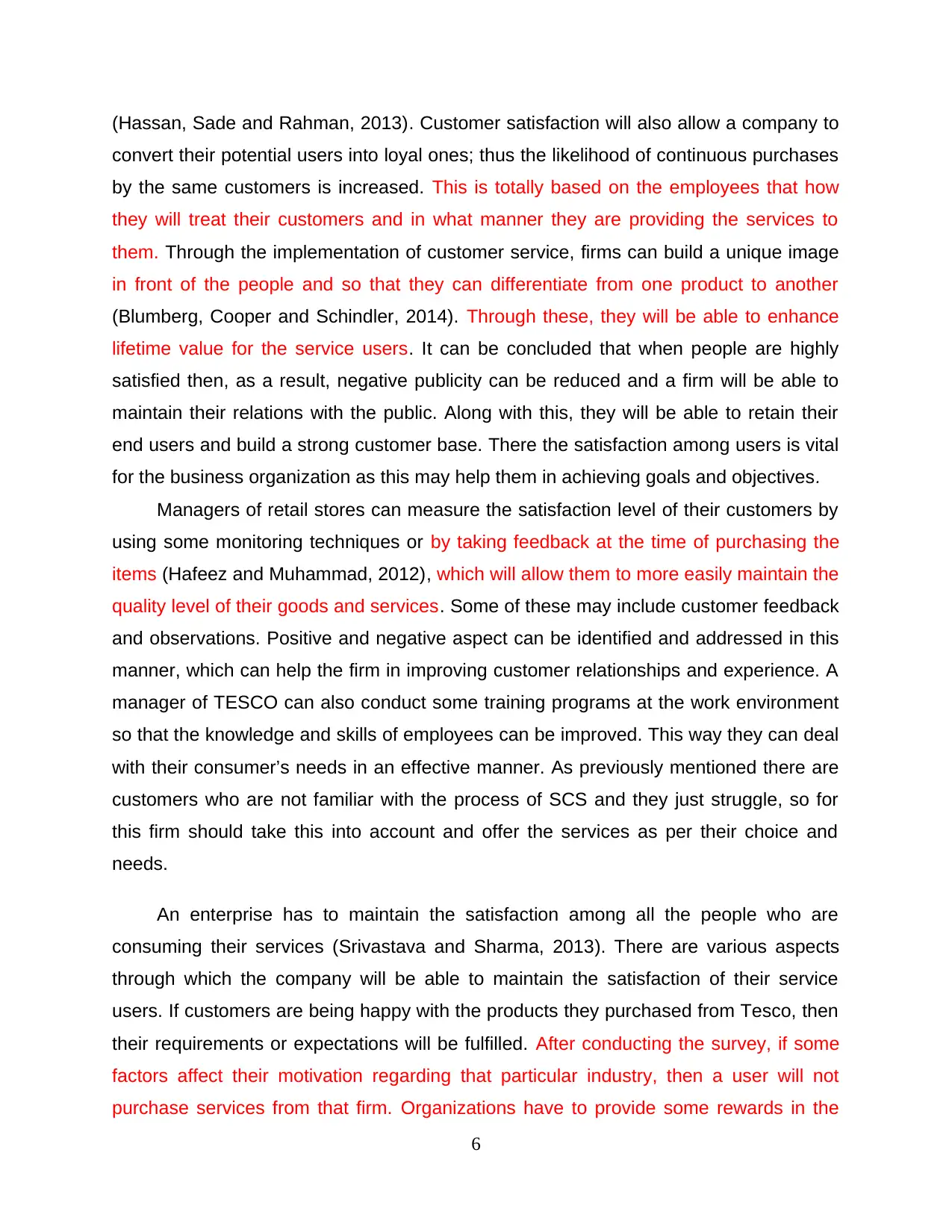
(Hassan, Sade and Rahman, 2013). Customer satisfaction will also allow a company to
convert their potential users into loyal ones; thus the likelihood of continuous purchases
by the same customers is increased. This is totally based on the employees that how
they will treat their customers and in what manner they are providing the services to
them. Through the implementation of customer service, firms can build a unique image
in front of the people and so that they can differentiate from one product to another
(Blumberg, Cooper and Schindler, 2014). Through these, they will be able to enhance
lifetime value for the service users. It can be concluded that when people are highly
satisfied then, as a result, negative publicity can be reduced and a firm will be able to
maintain their relations with the public. Along with this, they will be able to retain their
end users and build a strong customer base. There the satisfaction among users is vital
for the business organization as this may help them in achieving goals and objectives.
Managers of retail stores can measure the satisfaction level of their customers by
using some monitoring techniques or by taking feedback at the time of purchasing the
items (Hafeez and Muhammad, 2012), which will allow them to more easily maintain the
quality level of their goods and services. Some of these may include customer feedback
and observations. Positive and negative aspect can be identified and addressed in this
manner, which can help the firm in improving customer relationships and experience. A
manager of TESCO can also conduct some training programs at the work environment
so that the knowledge and skills of employees can be improved. This way they can deal
with their consumer’s needs in an effective manner. As previously mentioned there are
customers who are not familiar with the process of SCS and they just struggle, so for
this firm should take this into account and offer the services as per their choice and
needs.
An enterprise has to maintain the satisfaction among all the people who are
consuming their services (Srivastava and Sharma, 2013). There are various aspects
through which the company will be able to maintain the satisfaction of their service
users. If customers are being happy with the products they purchased from Tesco, then
their requirements or expectations will be fulfilled. After conducting the survey, if some
factors affect their motivation regarding that particular industry, then a user will not
purchase services from that firm. Organizations have to provide some rewards in the
6
convert their potential users into loyal ones; thus the likelihood of continuous purchases
by the same customers is increased. This is totally based on the employees that how
they will treat their customers and in what manner they are providing the services to
them. Through the implementation of customer service, firms can build a unique image
in front of the people and so that they can differentiate from one product to another
(Blumberg, Cooper and Schindler, 2014). Through these, they will be able to enhance
lifetime value for the service users. It can be concluded that when people are highly
satisfied then, as a result, negative publicity can be reduced and a firm will be able to
maintain their relations with the public. Along with this, they will be able to retain their
end users and build a strong customer base. There the satisfaction among users is vital
for the business organization as this may help them in achieving goals and objectives.
Managers of retail stores can measure the satisfaction level of their customers by
using some monitoring techniques or by taking feedback at the time of purchasing the
items (Hafeez and Muhammad, 2012), which will allow them to more easily maintain the
quality level of their goods and services. Some of these may include customer feedback
and observations. Positive and negative aspect can be identified and addressed in this
manner, which can help the firm in improving customer relationships and experience. A
manager of TESCO can also conduct some training programs at the work environment
so that the knowledge and skills of employees can be improved. This way they can deal
with their consumer’s needs in an effective manner. As previously mentioned there are
customers who are not familiar with the process of SCS and they just struggle, so for
this firm should take this into account and offer the services as per their choice and
needs.
An enterprise has to maintain the satisfaction among all the people who are
consuming their services (Srivastava and Sharma, 2013). There are various aspects
through which the company will be able to maintain the satisfaction of their service
users. If customers are being happy with the products they purchased from Tesco, then
their requirements or expectations will be fulfilled. After conducting the survey, if some
factors affect their motivation regarding that particular industry, then a user will not
purchase services from that firm. Organizations have to provide some rewards in the
6
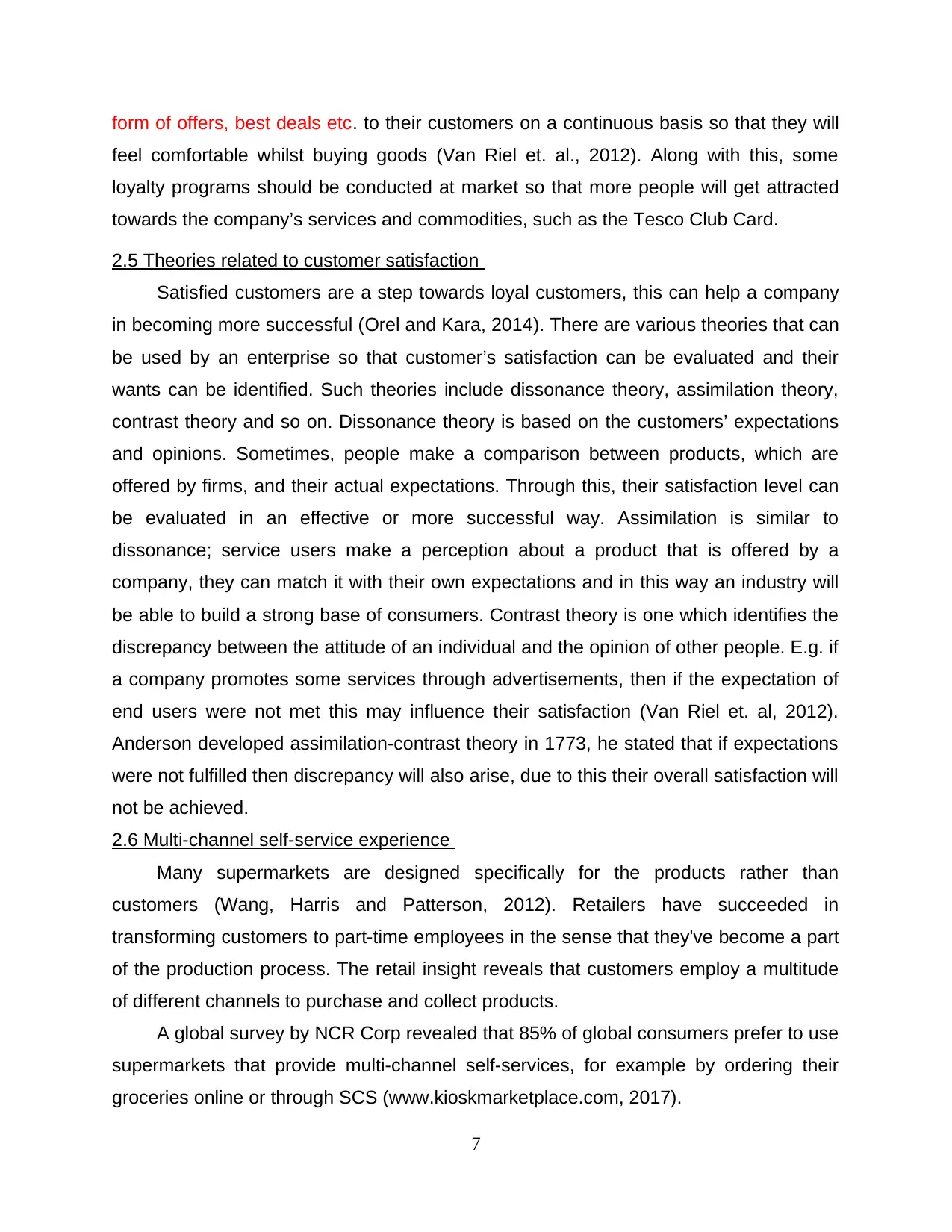
form of offers, best deals etc. to their customers on a continuous basis so that they will
feel comfortable whilst buying goods (Van Riel et. al., 2012). Along with this, some
loyalty programs should be conducted at market so that more people will get attracted
towards the company’s services and commodities, such as the Tesco Club Card.
2.5 Theories related to customer satisfaction
Satisfied customers are a step towards loyal customers, this can help a company
in becoming more successful (Orel and Kara, 2014). There are various theories that can
be used by an enterprise so that customer’s satisfaction can be evaluated and their
wants can be identified. Such theories include dissonance theory, assimilation theory,
contrast theory and so on. Dissonance theory is based on the customers’ expectations
and opinions. Sometimes, people make a comparison between products, which are
offered by firms, and their actual expectations. Through this, their satisfaction level can
be evaluated in an effective or more successful way. Assimilation is similar to
dissonance; service users make a perception about a product that is offered by a
company, they can match it with their own expectations and in this way an industry will
be able to build a strong base of consumers. Contrast theory is one which identifies the
discrepancy between the attitude of an individual and the opinion of other people. E.g. if
a company promotes some services through advertisements, then if the expectation of
end users were not met this may influence their satisfaction (Van Riel et. al, 2012).
Anderson developed assimilation-contrast theory in 1773, he stated that if expectations
were not fulfilled then discrepancy will also arise, due to this their overall satisfaction will
not be achieved.
2.6 Multi-channel self-service experience
Many supermarkets are designed specifically for the products rather than
customers (Wang, Harris and Patterson, 2012). Retailers have succeeded in
transforming customers to part-time employees in the sense that they've become a part
of the production process. The retail insight reveals that customers employ a multitude
of different channels to purchase and collect products.
A global survey by NCR Corp revealed that 85% of global consumers prefer to use
supermarkets that provide multi-channel self-services, for example by ordering their
groceries online or through SCS (www.kioskmarketplace.com, 2017).
7
feel comfortable whilst buying goods (Van Riel et. al., 2012). Along with this, some
loyalty programs should be conducted at market so that more people will get attracted
towards the company’s services and commodities, such as the Tesco Club Card.
2.5 Theories related to customer satisfaction
Satisfied customers are a step towards loyal customers, this can help a company
in becoming more successful (Orel and Kara, 2014). There are various theories that can
be used by an enterprise so that customer’s satisfaction can be evaluated and their
wants can be identified. Such theories include dissonance theory, assimilation theory,
contrast theory and so on. Dissonance theory is based on the customers’ expectations
and opinions. Sometimes, people make a comparison between products, which are
offered by firms, and their actual expectations. Through this, their satisfaction level can
be evaluated in an effective or more successful way. Assimilation is similar to
dissonance; service users make a perception about a product that is offered by a
company, they can match it with their own expectations and in this way an industry will
be able to build a strong base of consumers. Contrast theory is one which identifies the
discrepancy between the attitude of an individual and the opinion of other people. E.g. if
a company promotes some services through advertisements, then if the expectation of
end users were not met this may influence their satisfaction (Van Riel et. al, 2012).
Anderson developed assimilation-contrast theory in 1773, he stated that if expectations
were not fulfilled then discrepancy will also arise, due to this their overall satisfaction will
not be achieved.
2.6 Multi-channel self-service experience
Many supermarkets are designed specifically for the products rather than
customers (Wang, Harris and Patterson, 2012). Retailers have succeeded in
transforming customers to part-time employees in the sense that they've become a part
of the production process. The retail insight reveals that customers employ a multitude
of different channels to purchase and collect products.
A global survey by NCR Corp revealed that 85% of global consumers prefer to use
supermarkets that provide multi-channel self-services, for example by ordering their
groceries online or through SCS (www.kioskmarketplace.com, 2017).
7
⊘ This is a preview!⊘
Do you want full access?
Subscribe today to unlock all pages.

Trusted by 1+ million students worldwide
1 out of 41
Related Documents
Your All-in-One AI-Powered Toolkit for Academic Success.
+13062052269
info@desklib.com
Available 24*7 on WhatsApp / Email
![[object Object]](/_next/static/media/star-bottom.7253800d.svg)
Unlock your academic potential
Copyright © 2020–2025 A2Z Services. All Rights Reserved. Developed and managed by ZUCOL.




